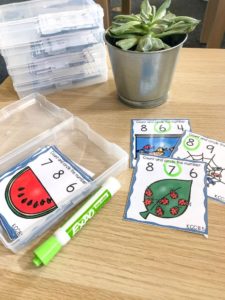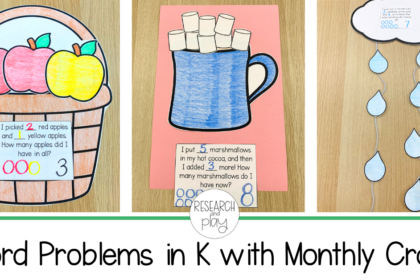One thing I’ve learned since moving away from whole group math instruction is that I need to make sure I have plenty of differentiated activities for my students. In math specifically, I’ve found that my students need plenty of opportunities to practice skills in ways that both review and extend what they’ve learned. Math skills seem to need more spiral and exposure than some other skills that I teach, so I have to be sure that I provide those opportunities.
I like to make sure that my students get plenty of different kinds of opportunities to practice math skills. In my rotation model, which is explained in much more detail in
this post, my students get exposure to math skills in four kinds of rotations: meet with the teacher (small group instruction), hands-on learning (counting collections with extensions), collaborative work (games and centers), and technology. While I was able to find a good variety of activities for these rotations, sometimes I found myself needing an activity that was straight to the point with a clear connection to the standard(s) I was teaching.
That’s where task cards came in. Although I knew about task cards, I was skeptical that my kindergartners would be able to use them independently (after modeling) or would enjoy using them. I made my first set while we were working on the Counting and Cardinality strand and brought them out during my small group. To my surprise, the kids not only needed minimal modeling but were also having fun using them! When our clean-up timer came on, they asked if they could “play this game” again next time. My students proved that task cards could work!
Task cards are…
In my opinion, I think that task cards:
- ARE simple ways to extend a skill that you have been working on
- ARE straight-forward ways to reteach a skill that students need more support with
- ARE easily used to assess students growth with a standard
- ARE fun ways for kids to work together
- are NOT something to give kindergartners as an early-finisher activity
- are NOT meant to be out all the time
- are NOT used to their maximum potential!
After watching that first group of kids use task cards, I knew that there was a place in my instruction for them. I wanted my students to use them in a variety of ways so that I could get the biggest bang for my buck, so to speak. After a few months of trying them out, I’ve found 3 ways that make the most sense for me.
Reteaching: Using task cards to support
I’d mostly seen task cards as something teachers would use as an extension activity, which is what I set out to use them for myself. However, I realized that some skills were consistently coming back up in my small group instruction because kids needed more time with them. I started using the task cards that correlated with those skills to reteach, and my students responded.
The best example of this was when we were working on teen numbers, a huge focus of study in kindergarten math. Specifically, we were working on learning that teen numbers have a group of ten and a set of ones. We had used other activities in the instruction of this skill, including task cards, but some groups needed more exposure. The first time they used the K.NBT task cards, they were not successful. So for a few weeks, I would bring the task cards out in my small group along with base ten rods and cubes. Every time my students pulled a task card, I had them first solve with the base ten blocks, then write how they solved on their task card. The visual helped so much! Eventually, they did not need the blocks to see that a 14 was a 10 and a 4.
Using task cards in this way allowed me to still give students the hands-on support that they needed while also giving them the structure of breaking apart teen numbers on the task cards. They were able to use both equations and number bonds to compose and decompose teens after a few weeks of reteaching!
Extending: Using task cards to progress
This is how I envisioned task cards being primarily used in my classroom. I wanted my students to use task cards to solidify and progress what they were currently learning. One thing I wanted to be sure of after I began using rotations to teach math was that I did not want my students to learn how to do an activity well, but to show knowledge of a standard well. Does that make sense? I wanted to give enough variety of activities so that no matter the format they were using, students would be able to show understanding of a skill. Whether they were using task cards, a game, an app, their workbook, etc., they would be able to show that they could apply what they knew about a given standard or skill.
So, I ended up creating task cards for every* kindergarten math standard! I wanted to be sure that my students could have a simple way of practicing each skill that I taught, including the Measurement and Data strand (which seems tricky to do with a task card, but we made it work!). The task cards are made available during my small group instruction and during collaborative work time. Students can turn them into a game to play with a partner (after modeling) or can work on their own. I love watching how they like to use task cards depending on the skill.
The way I check for accuracy depends on where my students are working. If they are in a small group with me, I like them to make a stack of their completed task cards. As they are working, I can go through their stacks and check in real time, then erase the card if it’s correct. If I see an error, I won’t erase it but will give it back to the student and say, “Try this one again!” Simple. I have about 6 kids in each small group, so I’m able to do this real-time checking. If a student gets done quickly, I have them help me check if I think they are able to do so.
If students are working in their collaborative group with a friend, I use Seesaw. Once a student/pair of students finishes a set of task cards, they will use Seesaw to either take a picture or video of what they did and record themselves explaining their work. My students are used to doing this with counting collections and during word study rotations. It took some explicit modeling early in the year, but my students are very proficient at Seesaw now! I watch the videos after school and leave voice comments as feedback that they can hear and use.
*There are 2 standards in the entire band of K math standards that are not included in these task cards because of how I believe they are best taught. The K.CC.B.4 standard (counting sets of objects) isn’t included because I believe that
counting collections are the best tool for practicing this skill and are much more easily used than a task card would be in this instance. The K.OA.A.2 standard (solving word problems) isn’t included because I believe the problems would be too basic if used with a task card, so I use these editable
joining and separating problems as well as these
fair share problems instead!
Assessing: Using task cards to monitor growth
In the same way that I use task cards for extension in my small group, I can use them for assessing students’ growth on a standard. For this purpose, though, my students work independently on the task cards specific to a standard I want to assess. All you need are the cards, a dry erase marker, and a method of recording students’ progress. I typically use the Notes app in my iPad and just type a quick sentence about how each student performed. This gives me enough information to refer back to and tailor my instruction for the next time I meet with those students.
I specifically don’t use a checklist, rubric, or any other template to help me assess because I believe that sometimes we get too caught up in the method rather than the result when it comes to assessing. What I’ve always disliked is how formal math assessment can be in kindergarten. Each student getting pulled one-on-one is exhausting and doesn’t feel like a true measure of a student’s “in the moment” knowledge of a skill. I’d rather assess while kids are working or playing, taking notes of their performance.
Using task cards, I’m able to assess and see very clearly if a student is struggling with a skill. I may make a note like this: Ava breaks apart teen numbers by digit (15 is 1 and 5). This gives me enough information to know what I need to help her with the next time we meet. It doesn’t have to be fancy, detailed, or formal. It just needs to inform my instruction. I always do this “assessing” in my small group, and I give different task cards to each student. This way, they are working on their own and I get a true measure of their understanding.
Storage, Logistics, and Links…
I’ve found that these plastic organizers work really well for storing our task cards (I got mine at Michael’s). I don’t currently have the boxes labeled, but I will likely add color stickers to each box that correlates with the standard (green stickers for K.CC, blue for K.OA, and so on). For now, I pull the boxes out that I want my students to use so the color organization would really only benefit me. I keep this organizer on my math shelf along with all of the other math materials that my students access on a daily basis.
I don’t have task cards out every day during rotation time. This keeps them fresh and exciting, in my opinion. I think that all activities should be rotated and changed out so that students keep an interest! I currently use task cards about twice a week, and since they include a variety of cards for each standard, I may not get out all of the task cards at once. My students get excited when I bring them out because they see them as a game! I usually call them “math card games” because what kindergartner wants to work on “task cards?”
Modeling is very important when introducing task cards in K. That’s why I always introduce them in my small group before I make them available during collaborative groups. I may teach a set of cards twice before my students are able to do them independently, but some are simple enough that it only takes one round of modeling before they’re off on their own. I kept the formatting and directions very basic so that kindergartners could do them as independently as possible.
If you would like to see just how beneficial task cards can be in your math instruction, you can click on the links above. I also put all of the cards in a bundle (over 400 cards total!) for you to purchase and save money! That link is also included. If you use these task cards, please let me know! I’d love to hear how your students respond and how you use them!




